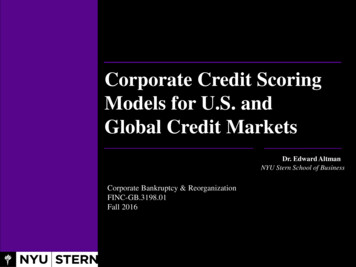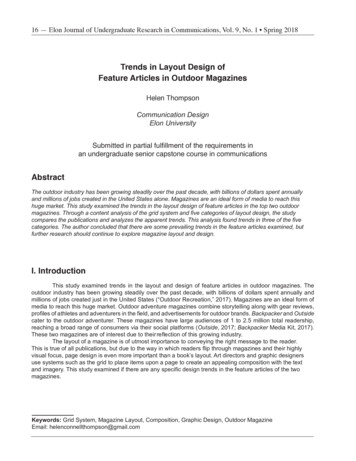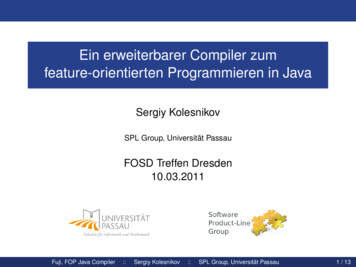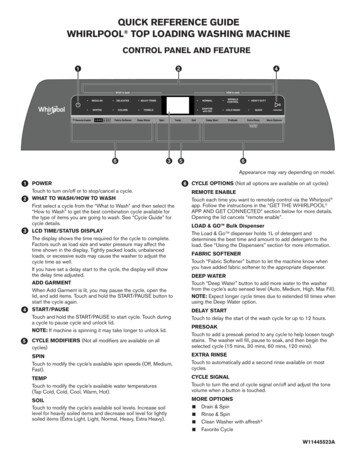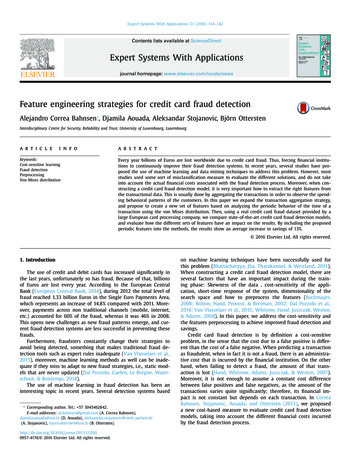
Transcription
Expert Systems With Applications 51 (2016) 134–142Contents lists available at ScienceDirectExpert Systems With Applicationsjournal homepage: www.elsevier.com/locate/eswaFeature engineering strategies for credit card fraud detectionAlejandro Correa Bahnsen , Djamila Aouada, Aleksandar Stojanovic, Björn OtterstenInterdisciplinary Centre for Security, Reliability and Trust, University of Luxembourg, Luxembourga r t i c l ei n f oKeywords:Cost-sensitive learningFraud detectionPreprocessingVon Mises distributiona b s t r a c tEvery year billions of Euros are lost worldwide due to credit card fraud. Thus, forcing financial institutions to continuously improve their fraud detection systems. In recent years, several studies have proposed the use of machine learning and data mining techniques to address this problem. However, moststudies used some sort of misclassification measure to evaluate the different solutions, and do not takeinto account the actual financial costs associated with the fraud detection process. Moreover, when constructing a credit card fraud detection model, it is very important how to extract the right features fromthe transactional data. This is usually done by aggregating the transactions in order to observe the spending behavioral patterns of the customers. In this paper we expand the transaction aggregation strategy,and propose to create a new set of features based on analyzing the periodic behavior of the time of atransaction using the von Mises distribution. Then, using a real credit card fraud dataset provided by alarge European card processing company, we compare state-of-the-art credit card fraud detection models,and evaluate how the different sets of features have an impact on the results. By including the proposedperiodic features into the methods, the results show an average increase in savings of 13%. 2016 Elsevier Ltd. All rights reserved.1. IntroductionThe use of credit and debit cards has increased significantly inthe last years, unfortunately so has fraud. Because of that, billionsof Euros are lost every year. According to the European CentralBank (European Central Bank, 2014), during 2012 the total level offraud reached 1.33 billion Euros in the Single Euro Payments Area,which represents an increase of 14.8% compared with 2011. Moreover, payments across non traditional channels (mobile, internet,etc.) accounted for 60% of the fraud, whereas it was 46% in 2008.This opens new challenges as new fraud patterns emerge, and current fraud detection systems are less successful in preventing thesefrauds.Furthermore, fraudsters constantly change their strategies toavoid being detected, something that makes traditional fraud detection tools such as expert rules inadequate (Van Vlasselaer et al.,2015), moreover, machine learning methods as well can be inadequate if they miss to adapt to new fraud strategies, i.e., static models that are never updated (Dal Pozzolo, Caelen, Le Borgne, Waterschoot, & Bontempi, 2014).The use of machine learning in fraud detection has been aninteresting topic in recent years. Several detection systems based Corresponding author. Tel.: 57 3045462842.E-mail addresses: al.bahnsen@gmail.com (A. Correa Bahnsen),djamila.aouada@uni.lu (D. Aouada), aleksandar.stojanovic@rwth-aachen.de(A. Stojanovic), bjorn.ottersten@uni.lu (B. 2.0300957-4174/ 2016 Elsevier Ltd. All rights reserved.on machine learning techniques have been successfully used forthis problem (Bhattacharyya, Jha, Tharakunnel, & Westland, 2011).When constructing a credit card fraud detection model, there areseveral factors that have an important impact during the training phase: Skewness of the data , cost-sensitivity of the application, short-time response of the system, dimensionality of thesearch space and how to preprocess the features (Bachmayer,2008; Bolton, Hand, Provost, & Breiman, 2002; Dal Pozzolo et al.,2014; Van Vlasselaer et al., 2015; Whitrow, Hand, Juszczak, Weston,& Adams, 2008). In this paper, we address the cost-sensitivity andthe features preprocessing to achieve improved fraud detection andsavings.Credit card fraud detection is by definition a cost-sensitiveproblem, in the sense that the cost due to a false positive is different than the cost of a false negative. When predicting a transactionas fraudulent, when in fact it is not a fraud, there is an administrative cost that is incurred by the financial institution. On the otherhand, when failing to detect a fraud, the amount of that transaction is lost (Hand, Whitrow, Adams, Juszczak, & Weston, 2007).Moreover, it is not enough to assume a constant cost differencebetween false positives and false negatives, as the amount of thetransactions varies quite significantly; therefore, its financial impact is not constant but depends on each transaction. In CorreaBahnsen, Stojanovic, Aouada, and Ottersten (2013), we proposeda new cost-based measure to evaluate credit card fraud detectionmodels, taking into account the different financial costs incurredby the fraud detection process.
A. Correa Bahnsen et al. / Expert Systems With Applications 51 (2016) 134–142When constructing a credit card fraud detection model, it isvery important to use those features that allow accurate classification. Typical models only use raw transactional features, such astime, amount, place of the transaction. However, these approachesdo not take into account the spending behavior of the customer,which is expected to help discover fraud patterns (Bachmayer,2008). A standard way to include these behavioral spending patterns is proposed in (Whitrow et al., 2008), where Whitrow et al.proposed a transaction aggregation strategy in order to take intoaccount a customer spending behavior. The computation of the aggregated features consists in grouping the transactions made during the last given number of hours, first by card or account number, then by transaction type, merchant group, country or other,followed by calculating the number of transactions or the totalamount spent on those transactions.In this paper we first propose a new savings measure basedon comparing the financial cost of an algorithm versus using nomodel at all. Then, we propose an expanded version of the transaction aggregation strategy, by incorporating a combination criteria when grouping transactions, i.e., instead of aggregating only bycard holder and transaction type, we combine it with country ormerchant group. This allows to have a much richer feature space.Moreover, we also propose a new method for extracting periodic features in order to estimate if the time of a new transactionis within the confidence interval of the previous transaction times.The motivation is that a customer is expected to make transactionsat similar hours. The proposed methodology is based on analyzingthe periodic behavior of a transaction time, using the von Misesdistribution (Fisher, 1995).Furthermore, using a real credit card fraud dataset providedby a large European card processing company, we compare thedifferent sets of features (raw, aggregated, extended aggregatedand periodic), using two kind of classification algorithms; costinsensitive (Hastie, Tibshirani, & Friedman, 2009) and exampledependent cost-sensitive (Elkan, 2001). The results show anaverage increase in the savings of 13% by using the proposed periodic features. Additionally, the outcome of this paper is being currently used to implement a state-of-the-art fraud detection system,that will help to combat fraud once the implementation stage isfinished.The remainder of the paper is organized as follows. In Section 2,we explain the background on credit card fraud detection, andspecifically the measures to evaluate a fraud detection model. Thenin Section 3, we discuss current approaches to create the featuresused in fraud detection models, moreover, we present our proposed methodology to create periodic based features. Afterwards,the experimental setup is given in Section 4. In Section 5, the results are shown. Finally, conclusions and discussions of the paperare presented in Section 6.2. Credit card fraud detection evaluationA credit card fraud detection algorithm consists in identifyingthose transactions with a high probability of being fraud, basedon historical fraud patterns. The use of machine learning in frauddetection has been an interesting topic in recent years. Different detection systems that are based on machine learning techniques have been successfully used for this problem, in particular: neural networks (Maes, Tuyls, Vanschoenwinkel, & Manderick,2002), Bayesian learning (Maes et al., 2002), artificial immune systems (Bachmayer, 2008), association rules (Sánchez, Vila, Cerda, &Serrano, 2009), hybrid models (Krivko, 2010), support vector machines (Bhattacharyya et al., 2011), peer group analysis (Weston,Hand, Adams, Whitrow, & Juszczak, 2008), random forest (CorreaBahnsen et al., 2013; Dal Pozzolo et al., 2014), discriminant135Table 1Classification confusion matrix.Predicted positivec 1Predicted negativec 0Actual positivey 1Actual negativey 0True positive (TP)False positive (FP)False negative (FN)True positive (TN)Table 2Cost matrix (Elkan, 2001).Predicted positiveci 1Predicted negativeci 0Actual positiveyi 1Actual negativeyi 0CT PiCF PiCF NiCT Nianalysis (Mahmoudi & Duman, 2015) and social network analysis(Van Vlasselaer et al., 2015).Most of these studies compare their proposed algorithms with abenchmark algorithm and then make the comparison using a standard binary classification measure, such as misclassification error,receiver operating characteristic (ROC), Kolmogorov–Smirnov (KS),F1 Score (Bolton et al., 2002; Hand et al., 2007) or AUC statistics(Dal Pozzolo et al., 2014). Most of these measures are extracted byusing a confusion matrix as shown in Table 1, where the predictionof the algorithm ci is a function of the k features of transaction i,xi [x1i , x2i , . . . , xki ] and yi is the true class of the transaction i.From this table, several statistics are extracted. In particular:T P T NT P T N F P F NTP Recall T P F NTP Precision T P F PPrecision·Recall F1 Score 2Precision Recall Accuracy However, these measures may not be the most appropriateevaluation criteria when evaluating fraud detection models, because they tacitly assume that misclassification errors carry thesame cost, similarly with the correct classified transactions. Thisassumption does not hold in practice, when wrongly predictinga fraudulent transaction as legitimate carries a significantly different financial cost than the inverse case. Furthermore, the accuracy measure also assumes that the class distribution amongtransactions is constant and balanced (Provost, Fawcett, & Kohavi,1998), and typically the distributions of a fraud detection datasetare skewed, with a percentage of frauds ranging from 0.005% to0.5% (Bachmayer, 2008; Bhattacharyya et al., 2011).In order to take into account the different costs of fraud detection during the evaluation of an algorithm, we may use themodified cost matrix defined in (Elkan, 2001). In Table 2, the costmatrix is presented, where the cost assof correct classification,namely, true positives CT Pi , and true negatives CT Ni ; and the twotypes of misclassification errors, namely, false positives CF Pi , andfalse negatives CF Ni , are presented. This is an extension of Table 1,but in this case the costs are example-dependent, in other words,specific to each transaction i.Hand et al. (Hand et al., 2007) proposed a cost matrix, where inthe case of false positive the associated cost is the administrativecost CF Pi Ca related to analyzing the transaction and contactingthe card holder. This cost is the same assigned to a true positiveCT Pi Ca , because in this case, the card holder will have to be contacted. However, in the case of a false negative, in which a fraudis not detected, the cost is defined to be a hundred times larger,
136A. Correa Bahnsen et al. / Expert Systems With Applications 51 (2016) 134–142Table 4Summary of typical raw credit card fraud detection features.Table 3Credit card fraud cost matrix (Correa Bahnsen et al., 2013).Predicted positiveci 1Predicted negativeci 0Actual positiveyi 1Actual negativeyi 0CT Pi CaCF Pi CaCF Ni AmtiCT Ni 0i.e. CF Ni 100Ca . This same approach was also used in (Bachmayer,2008).Nevertheless, in practice, losses due to a specific fraud rangefrom few to thousands of Euros, which means that assuming constant cost for false negatives is unrealistic. In order to address thislimitation, in Correa Bahnsen et al. (2013), we proposed a cost matrix that takes into account the actual example-dependent financialcosts. Our cost matrix defines the cost of a false negative to be theamount CF Ni Amti of the transaction i. We argue that this costmatrix is a better representation of the actual costs, since in practice fraud detection teams are measured by either by total monetary savings or total amount saved, while it may be of interest to afinancial institution to minimize false positives, the ultimately goalof the company is to maximize profits which is better addressed bythe minimization of the financial costs. The costs are summarizedin Table 3.Moreover, this framework is flexible enough to include additional costs such as one that takes into account the expected intangible cost by an irritated customer due to a false positive, or onthe other hand, the profit due to a satisfy customer that feels safeby being contacted by the bank.Afterwards, using the example-dependent cost matrix, a costmeasure is calculated taking into account the actual costs[CT Pi , CF Pi , CF Ni , CT Ni ] of each transaction i. Let S be a set of N transactions i, N S , where each transaction is represented by theaugmented feature vector x i [xi , CT Pi , CF Pi , CF Ni , CT Ni ], and labelledusing the class label yi {0, 1}. A classifier f which generates thepredicted label ci for each transaction i, is trained using the set S.Then the cost of using f on S is calculated byCost ( f (S )) N yi (ciCT Pi (1 ci )CF Ni )i 1 (1 yi )(ciCF Pi (1 ci )CT Ni ) . N yi (1 ci )Amti ciCa .(1)i 1However, as noted in (Whitrow et al., 2008), the total cost maynot be easy to interpret. So Whitrow et al. proposed a normalizedcost measure by dividing the total cost by the theoretical maximum cost, which is the cost of misclassifying every example.Costn ( f (S )) Nyi (1 ci )Amti ciCa, S0 Ca Ni 1 Amti · 11 (yi )i 1(2)where, S0 {x i yi 0, i 1, . . . , N}, and 1c (z) is an indicator function that takes the value of one if z c and zero if z c .We propose a similar approach in Correa Bahnsen, Aouada, andOttersten (2015), by defining the savings of using an algorithm asthe cost of the algorithm versus the cost of using no algorithm atall. To do that, we set the cost of using no algorithm asCostl (S ) min{Cost ( f0 (S )), Cost ( f1 (S ))},(3)where f0 refers to a classifier that predicts all the examples in S asbelonging to the class c0 , and similarly f1 refers to a classifier thatpredicts all the examples in S as belonging to the class c1 , the costAttribute nameDescriptionTransaction IDTimeAccount numberCard numberTransaction typeEntry modeAmountMerchant codeMerchant groupCountryCountry 2Type of cardGenderAgeBankTransaction identification numberDate and time of the transactionIdentification number of the customerIdentification of the credit cardie. Internet, ATM, POS, .ie. Chip and pin, magnetic stripe, .Amount of the transaction in EurosIdentification of the merchant typeMerchant group identificationCountry of trxCountry of residenceie. Visa debit, Mastercard, American Express.Gender of the card holderCard holder ageIssuer bank of the cardimprovement can be expressed as the cost savings as comparedwith Costl (S ).Savings( f (S )) Costl (S ) Cost ( f (S )).Costl (S )(4)Moreover, in the case of credit card fraud the cost of using no algorithm is equal to the sum of the amounts of the fraudulent transac tions Costl (S ) Ni 1 yi Amti . Then, the savings are calculated as:Savings( f (S )) Nyi ci Amti ciCa. Ni 1 yi Amtii 1(5)In other words, the sum of the amounts of the corrected predictedfraudulent transactions minus the administrative cost incurred indetect them, divided by the sum of the amounts of the fraudulenttransactions.For our analysis, we choose to use the savings measure insteadof the normalized cost, since in the field of credit card fraud detection, a general observation is that companies do not use predictivemodels. Therefore, the savings measure makes more sense for thisapplication. Indeed the savings measure may lead to negative values which is counterintuitive, however, in the industry it makessense to compare the results of the algorithm versus not using anyalgorithm at all.Lastly, it may be argued that this example-dependent strategy isfocusing solely on large amount transaction and that smaller fraudswould not matter. However, this framework is flexible enough toallow modifying the cost matrix to include the available amount inthe credit card as the cost of a false negative. Then, small amountfrauds with a high potential loss would have a higher importance,because a lot of money is available in the credit card.3. Feature engineering for fraud detectionWhen constructing a credit card fraud detection algorithm, theinitial set of features (raw features) include information regarding individual transactions. It is observed throughout the literature,that regardless of the study, the set of raw features is quite similar. This is because the data collected during a credit card transaction must comply with international financial reporting standards(American Institute of CPAs, 2011). In Table 4, the typical creditcard fraud detection raw features are summarized.3.1. Capturing customer spending patternsSeveral studies use only the raw features in carrying their analysis (Brause, Langsdorf, & Hepp, 1999; Minegishi & Niimi, 2011;Panigrahi, Kundu, Sural, & Majumdar, 2009; Sánchez et al., 2009).
A. Correa Bahnsen et al. / Expert Systems With Applications 51 (2016) 134–142However, as noted in (Bolton & Hand, 2001), a single transaction information is not sufficient to detect a fraudulent transaction, since using only the raw features leaves behind importantinformation such as the consumer spending behavior, which isusually used by commercial fraud detection systems (Whitrowet al., 2008).To deal with this, in (Bachmayer, 2008), a new set of featureswere proposed such that the information of the last transactionmade with the same credit card is also used to make a prediction.The objective, is to be able to detect very dissimilar continuoustransactions within the purchases of a customer. The new set offeatures include: time since the last transaction, previous amountof the transaction, previous country of the transaction. Nevertheless, these features do not take into account consumer behaviorother than the last transaction made by a client, this leads to having an incomplete profile of customers.A more compressive way to take into account a customerspending behavior is to derive some features using a transactionaggregation strategy. This methodology was initially proposed in(Whitrow et al., 2008). The derivation of the aggregation featuresconsists in grouping the transactions made during the last givennumber of hours, first by card or account number, then by transaction type, merchant group, country or other, followed by calculating the number of transactions or the total amount spent onthose transactions. This methodology has been used by a numberof studies (Bhattacharyya et al., 2011; Correa Bahnsen et al., 2013;2014b; Dal Pozzolo et al., 2014; Jha, Guillen, & Christopher Westland, 2012; Sahin, Bulkan, & Duman, 2013; Tasoulis & Adams, 2008;Weston et al., 2008).When aggregating a customer transactions, there is an important question on how much to accumulate, i
ria onlyby card holder and transaction type, we combine it with country or merchantgroup.Thisallowstohaveamuch richerfeaturespace. Moreover, we also propose a n
